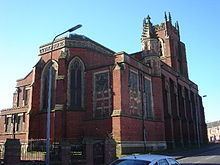OS grid reference SD 713,108 Denomination Anglican Opened 1881 Groundbreaking 1878 | Country England Founder(s) Thomas Greenhalgh Architectural type Church Architect Sharpe, Paley and Austin | |
 | ||
Construction cost 16,500 GBP (equivalent to £1,490,000 in 2014) Similar Church of St George - Bolton, St Stephen and All Martyrs' C, St Saviour's Church, St John the Evangelist's Church - F, St Maxentius' Church - B | ||
The Church of All Souls is a redundant Anglican church in Astley Street, Astley Bridge, Bolton, Lancashire, England. It is recorded in the National Heritage List for England as a designated Grade II* listed building, and is under the care of the Churches Conservation Trust. As of 2010, the church is being converted into a community centre.
Contents
Early history
The church was built between 1878 and 1881 and paid for by Thomas Greenhalgh, an Evangelical mill-owner. Thomas inherited the money from his brother Nathaniel, who had died in 1877, aged 60. It was one of two churches in the area financed from this inheritance, the other being St Saviour's. The total cost of the church, including fittings, the stained glass, the organ, and the boundary walls, was £23,000 (equivalent to £2,090,000 in 2015). The local population had grown during the second half of the 19th century, and the church was intended to serve the people working in the nearby mills. It was designed by the Lancaster architects Paley and Austin. The church was planned to seat a congregation of about 800, giving them all a good view of the proceedings, and an opportunity to hear the sermon. The contractors were Cordingley and Stopford of Manchester. The church was consecrated in 1881 by Dr J. Fraser, Bishop of Manchester. Few changes have been made to the church since then. A war memorial was added to commemorate the parishioners who had died serving in the First World War.
Exterior
All Souls is constructed in brick with dressings of Longridge sandstone. The interior is dressed with Stourton stone. The roofs are of slate. Its plan consists of a five-bay nave, a two-bay chancel with a canted apse, an organ chamber to the north, and a chapel and vestry to the south, and a west tower with a protruding north porch and stair turret. There are no aisles. The tower has four stages. It is 118 feet (36 m) high. In the lowest stage is a west door over which is a frieze and a three-light traceried window. The north porch is gabled. The second stage contains a round window. In the third stage are two small windows and a three-light bell opening containing Perpendicular tracery. Around the top of the tower is a traceried parapet with crocketed pinnacles at the corners. The nave is divided into bays by buttresses and at the corners of the east end are octagonal pinnacles with crocketted caps. In the bays are two tiers of three-light windows with Perpendicular tracery. The windows in the chapels are flat-headed. In the chancel the windows are in two tiers, with one of four lights and two of two lights. A parapet decorated with a quatrefoil frieze runs round the top of the chancel.
Interior
The interior is constructed without any pillars, making it a single, undivided space, with a span of 52 feet (16 m), one of the widest for a parish church in England. It was built in this way to give the congregation an excellent view of the chancel from the nave, and the ability to hear the sermon clearly. At the west end is a small gallery. To provide the wide interior, the timber roof has a complex structure with rib vaulting. The vaulting is carried on octagonal shafts between the windows. On the sides of the chancel are two-bay arcades. The reredos is in stone, and consists of traceried panels, the outer ones of which are inscribed with prayers and other text. The reredos and the font were designed by John Roddis of Birmingham. The choir stalls, pews, organ case, altar, communion rails, credence table, and pulpit are in oak and were all designed by the architects. The stained glass in the apse depicts scenes from the New Testament. It was designed by the architects and made by Clayton and Bell. The windows are dedicated to the memory of Thomas Greenhalgh's brother, Nathaniel. The stained glass in the east chancel windows is dated 1887 and depicts Faith and Hope; it was made by Burlison and Grylls. The two-manual organ was built in 1881 by Isaac Abbott of Leeds. There is a ring of eight bells, all cast in 1881 by John Taylor & Co of Loughborough.
Recent history and present day
During the 20th century the size of the local population was declining, and in 1962 the parish was combined with that of St James in Waterloo Road. In 1970 the stained glass windows in the tower were removed. They had depicted the Creation and were made by Shrigley and Hunt, but had been damaged by vandalism. The church closed in 1986 and was vested in the Churches Conservation Trust. The building has since been redeveloped and in December 2014 opened as a business and community centre, managed by a small charity set up for this purpose, known as All Souls Bolton.
